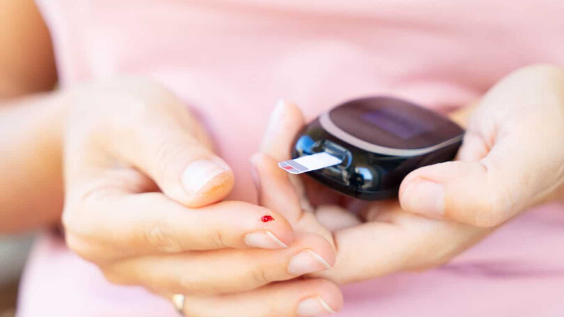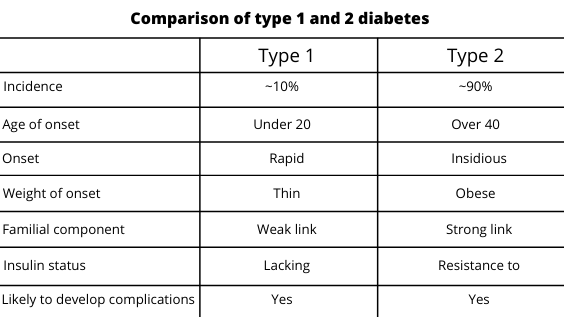
Diabetes mellitus is an increasingly common disorder in both affluent and developing societies. Diabetes millitus (DM) is a syndrome of impaired insulin secretion and/or resistance of cells and tissues to the influence of insulin. The end result is abnormally high blood sugar levels – hyperglycemia. Chronic diabetes is almost always complicated by other phenomena attributed to persistent hyperglycemia. It is these complications that account for the majority of the mortality and morbidity seen in chronic diabetics. The main cause of death related to diabetes are cardiovascular disease, stroke and kidney failure. Contributing to morbidity are blindness, gangrene, sensory deficit, peripheral neuropathy and chronic skin infections.
Type 1
Type 1 DM usually occurs during adolescence and is associated with autoimmune or infectious destruction of insulin producing cells of the pancreas. A genetic susceptibility, in combination with viral or environment exposure to triggers, starts a cascade of events resulting in the destruction of these cells. Destruction progresses subclinically over time until few cells remain, and insulin levels are too low to maintain blood glucose control. Since the pancreas no longer produces insulin, the insulin must be replaced and patients are medicated with insulin injections.
Type 2
Type 2 DM is characterized by resistance of target cells to the influence of insulin. Insulin levels in the blood are high, especially in the early stages, but insulin cell receptors are insensitive and glucose is not transported into cells. The glucose remains in the blood stream, resulting in hyperglycemia. Type 2 DM usually appears in middle age, develops gradually and may take years before diagnosis, at which time around 35% of patients develop complications. There is a strong link to obesity, however patients can be obese without developing diabetes, not all type 2 diabetics are obese. Some people have a genetic predisposition to insulin resistance, while others develop the condition because of an unhealthy diet, lifestyle and high stress. A diet high in carbohydrate and sugar causes the pancreas to overproduce insulin. The cells of the body are overwhelmed by this excess insulin and protect themselves by reducing the number of insulin receptor sites on their surface. Consequently there are too few sites for insulin to carry out its normal function of allowing glucose to pass through the cell wall to be converted into energy.

Signs and Symptoms
The classic symptoms of DM are:
> Polydispia: increased thirst due to decrease in fluid volume and dehydration from excessive urination, and increased osmolarity of blood and extracellular fluids.
> Polyphangia: Increased hunger as glucose lost in the urine is unavailable for essential metabolic activity.
> Polyuria: Increased urinary frequency and volume caused by osmotic diuresis from high levels of glucose in the urine; fluid loss leads to low blood pressure and dehydration.
> Hyperglycemia can also cause weight loss, nausea, vomiting, blurred vision, and predisposition to bacterial or fungal infections.
> Dehydration and inability of glucose to enter cells causes weakness and fatigue, and, when severe, cognitive disturbances.
Chinese Medicine Pathology
The pathology of DM can be seen in terms of the six divisions. The majority of diabetic pathology occurs within the taiyin and shaoyin divisions. The taiyin pertains to the Spleen and Lungs, while the shaoyin pertains to the Kidneys and Heart. Hyperglycemia is common to both type 1 and 2 diabetes, and is due to failure of Spleen transformation. In type 1 DM, failure of the Spleen transformation is due to the Spleen not being supported by the Kidney; in type 2 DM it is due to direct damage to the Spleen by diet or emotional factors.
Type 2 DM starts with taiyin dysfunction, which over time, starts to involve to support taiyin. In practice, the majority of patients have impairment of both the taiyin and shaoyin divisions to one degree or another. The more chronic and severe the disease, the more shaoyin pathology, and the more the Heart and vessels are damaged. When uncontrolled, shaoyin pathology can lapse into the final and severe jueyin division, leading to coma and death.
Chinese Medicine Etiology
> Diet and medications:
> Inherited constitution:
> Emotional factors
> Exhaustion, overwork, pregnancy
Chinese Medicine Treatment
The main aim of treatment in diabetes is to regulate blood glucose levels while correcting the imbalances that enabled it to occur. Exercise, management of the diet, weight loss are the first line of therapy for all type 2 DM patients, and in many cases acupuncture and herbal treatment can help keep the blood sugar under control, while gradually improving their constitutional health and general wellbeing.
